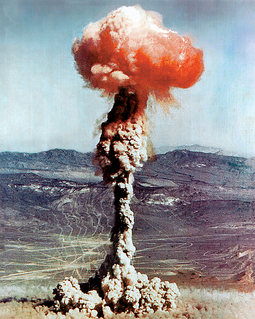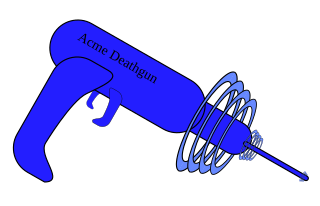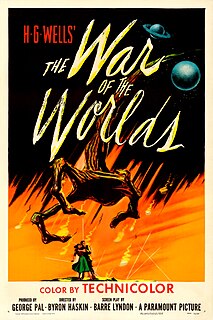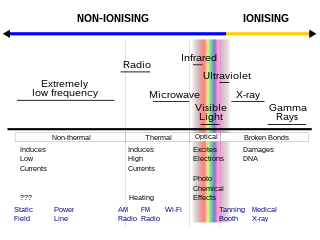
In physics, electromagnetic radiation refers to the waves of the electromagnetic field, propagating (radiating) through space, carrying electromagnetic radiant energy. It includes radio waves, microwaves, infrared, (visible) light, ultraviolet, X-rays, and gamma rays.

Infrared (IR), sometimes called infrared light, is electromagnetic radiation (EMR) with wavelengths longer than those of visible light. It is therefore generally invisible to the human eye, although IR at wavelengths up to 1050 nanometers (nm)s from specially pulsed lasers can be seen by humans under certain conditions. IR wavelengths extend from the nominal red edge of the visible spectrum at 700 nanometers, to 1 millimeter (300 GHz). Most of the thermal radiation emitted by objects near room temperature is infrared. As with all EMR, IR carries radiant energy and behaves both like a wave and like its quantum particle, the photon.

In physics, radiation is the emission or transmission of energy in the form of waves or particles through space or through a material medium. This includes:
Nuclear engineering is the branch of engineering concerned with the application of breaking down atomic nuclei (fission) or of combining atomic nuclei (fusion), or with the application of other sub-atomic processes based on the principles of nuclear physics. In the sub-field of nuclear fission, it particularly includes the design, interaction, and maintenance of systems and components like nuclear reactors, nuclear power plants, or nuclear weapons. The field also includes the study of medical and other applications of radiation, particularly Ionizing radiation, nuclear safety, heat/thermodynamics transport, nuclear fuel, or other related technology and the problems of nuclear proliferation. This field also includes chemical engineering and electrical engineering as well.
A neutron bomb, officially defined as a type of enhanced radiation weapon (ERW), is a low yield thermonuclear weapon designed to maximize lethal neutron radiation in the immediate vicinity of the blast while minimizing the physical power of the blast itself. The neutron release generated by a nuclear fusion reaction is intentionally allowed to escape the weapon, rather than being absorbed by its other components. The neutron burst, which is used as the primary destructive action of the warhead, is able to penetrate enemy armor more effectively than a conventional warhead, thus making it more lethal as a tactical weapon.

Nuclear technology is technology that involves the nuclear reactions of atomic nuclei. Among the notable nuclear technologies are nuclear reactors, nuclear medicine and nuclear weapons. It is also used, among other things, in smoke detectors and gun sights.

The Core is a 2003 American science fiction disaster film directed by Jon Amiel and starring Aaron Eckhart, Hilary Swank, Delroy Lindo, Stanley Tucci, Tchéky Karyo, DJ Qualls, Bruce Greenwood and Alfre Woodard. The film focuses on a team whose mission is to drill to the center of the Earth and set off a series of nuclear explosions in order to restart the rotation of the Earth's core. The film was released on March 28, 2003 by Paramount Pictures.

The effects of a nuclear explosion on its immediate vicinity are typically much more destructive and multifaceted than those caused by conventional explosives. In most cases, the energy released from a nuclear weapon detonated within the lower atmosphere can be approximately divided into four basic categories:

Strange and exotic weapons are a recurring feature in science fiction. In some cases, weapons first introduced in science fiction have been made a reality; other science fiction weapons remain purely fictional, and are often beyond the realms of known physical possibility.

An X-ray tube is a vacuum tube that converts electrical input power into X-rays. The availability of this controllable source of X-rays created the field of radiography, the imaging of partly opaque objects with penetrating radiation. In contrast to other sources of ionizing radiation, X-rays are only produced as long as the X-ray tube is energized. X-ray tubes are also used in CT scanners, airport luggage scanners, X-ray crystallography, material and structure analysis, and for industrial inspection.
The Active Denial System (ADS) is a non-lethal, directed-energy weapon developed by the U.S. military, designed for area denial, perimeter security and crowd control. Informally, the weapon is also called the heat ray since it works by heating the surface of targets, such as the skin of targeted human subjects. Raytheon is currently marketing a reduced-range version of this technology. The ADS was deployed in 2010 with the United States military in the Afghanistan War, but was withdrawn without seeing combat. On August 20, 2010, the Los Angeles Sheriff's Department announced its intent to use this technology on prisoners in the Pitchess Detention Center in Los Angeles, stating its intent to use it in "operational evaluation" in situations such as breaking up prisoner fights. As of 2014, the ADS was only a vehicle-mounted weapon, though U.S. Marines and police were both working on portable versions. ADS was developed under the sponsorship of the Department of Defense Non-Lethal Weapons Program with the Air Force Research Laboratory as the lead agency. There are reports that Russia and China are developing their own versions of the Active Denial System.
In science fiction stories or Superhero comics, X-ray vision is the ability to see through physical objects at the discretion of the holder of this superpower. The most famous possessor of this ability is DC Comics' iconic superhero character, Superman.
The Heat-Ray is the primary offensive weapon used by the Martians in H. G. Wells' classic science fiction novel The War of the Worlds and its offshoots.
"There Will Come Soft Rains" is a short story by science fiction author Ray Bradbury which was first published in the May 6, 1950 issue of Collier's. Later that same year the story was included in Bradbury's The Martian Chronicles (1950).
Deathray is a post-punk genre band from Sacramento, California..
The death ray or death beam was a theoretical particle beam or electromagnetic weapon first theorized around the 1920s and 1930s. Around that time, notable inventors such as Guglielmo Marconi, Nikola Tesla, Harry Grindell Matthews, Edwin R. Scott, Graichen and others claimed to have invented it independently. In 1957, the National Inventors Council was still issuing lists of needed military inventions that included a death ray.

A raygun is a science fiction directed-energy weapon that fires what is usually destructive energy. They have various alternate names: ray gun, death ray, beam gun, blaster, laser gun, laser pistol, phaser, zap gun, etc. In most stories, when activated, a raygun emits a ray, typically visible, usually lethal if it hits a human target, often destructive if it hits mechanical objects, with properties and other effects unspecified or varying.

The War of the Worlds is a 1953 American science fiction film from Paramount Pictures, produced by George Pal, directed by Byron Haskin, and starring Gene Barry and Ann Robinson.
A black hole starship is a theoretical idea for enabling interstellar travel by propelling a starship by using a black hole as the energy source. The concept was first discussed in science fiction, notably in the book Imperial Earth by Arthur C. Clarke, and in the work of Charles Sheffield, in which energy extracted from a Kerr-Newman black hole is described as powering the rocket engines in the story "Killing Vector" (1978).

Non-ionizingradiation refers to any type of electromagnetic radiation that does not carry enough energy per quantum to ionize atoms or molecules—that is, to completely remove an electron from an atom or molecule. Instead of producing charged ions when passing through matter, non-ionizing electromagnetic radiation has sufficient energy only for excitation, the movement of an electron to a higher energy state. In contrast, ionizing radiation has a higher frequency and shorter wavelength than non-ionizing radiation, and can be a serious health hazard; exposure to it can cause burns, radiation sickness, cancer, and genetic damage. Using ionizing radiation requires elaborate radiological protection measures, which in general are not required with non-ionizing radiation.









